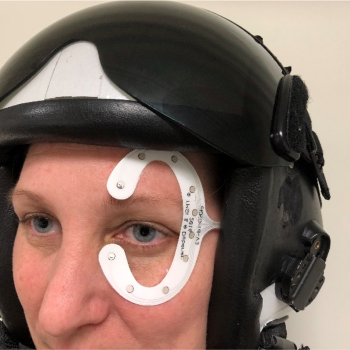Eye Tracking in Free-Living Conditions

Lincoln Laboratory is developing a prototype wearable device for tracking eye and head movements that can reveal a person's physiological and cognitive states. For example, some features of eye movements are symptomatic of fatigue. Critical personnel, such as first responders, pilots, or military members, can use this system to monitor their alertness and prevent fatigue-induced accidents. The system collects high-fidelity data continuously for days, making it suitable for extended use in free-living conditions.
Background
Eye movements provide insight into neurological function and physiological state. However, currently used devices for tracking and measuring eye movements have constraints that limit their adoption. Many commercial systems interface with sophisticated video equipment, making them large, costly, and poorly suited for rugged, natural environments. Head-mounted camera-based systems are often bulky, uncomfortable, and prone to errors caused by camera or head movement.
Electrooculography (EOG), which uses surface electrodes around the eye to measure eye movements, can enable a nonintrusive, mobile device. Unfortunately, EOG on its own requires frequent in-laboratory signal calibration to maintain high data quality. To break this limitation, Lincoln Laboratory developed a novel algorithm that fuses, in real time, EOG and gyroscope data to allow continual, automatic eye movement signal calibration in free-living conditions.
Lincoln Laboratory Design
As the eye rotates, the electrodes read the changing voltages indicative of eye movements. However, the absolute magnitude of the voltages is somewhat arbitrary because electrode placement and changes in the electrical characteristics of the wearer's skin, such as changes caused by sweat, cause the electrical signals to vary from person to person. Lincoln Laboratory developed an algorithm that fuses head and eye rotation data to yield a calibrated EOG signal that represents not just electrical responses but true angular rotation of the eye. The calibrated signals are robust to electrode placement, head-mount gyroscope placement, changes in the electrode-skin interface, and other variables.
Benefits
- Enables nonintrusive eye tracking that could benefit virtual reality training, physical therapy, and gaming
- Performs sensor fusion to continuously improve signal quality
- Provides the capability for real-time health and performance monitoring
- Maintains reliability under various electrode placements or skin conditions
Potential Use Cases
- Objective diagnosis of fatigue, sleep quality, eye dysfunction, or brain injury, or for detection of changes in an individual's neurophysiology
- Augmented virtual reality simulations, based on eye movements, for training scenarios or gaming